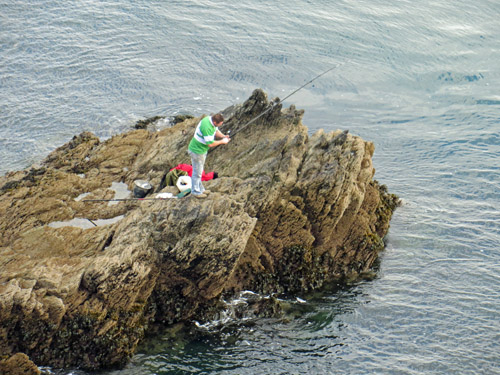- Home
- Shore Fishing
- Rock Fishing
The Risks and Rewards of
Rock Fishing
Some excellent catches can be made from rock fishing venues. Not just in terms of numbers, but the fish tend to be bigger too - probably because the trawlers can't get at them.
It's not too difficult to imagine what the conditions are like in the fishes' underwater domain - it will be an extension of what you see around you.
Rocky gullies, swirling currents, dense cover provided by beds of kelp - all reassuring stuff if you're a fish.
But for the fisherman, the downside of fishing over rocky ground - certainly when bottom fishing - is that tackle losses can be a little depressing. But there are ways of minimising them...
Minimising Tackle Losses when Rock Fishing
But there are things you can do to minimise this:~
- Use a rotten bottom, which is a short length of light line between
the lead and the terminal rig. Then, when the lead gets hung up an you
have to pull for a break, all you'll lose is your lead.
Incidentally, when you do have to pull for a break, don't risk damaging your rod. Just point the rod directly at the lead, harden up as much as you can, and walk backwards. The line should then snap at its weakest point. - Use a rig designed for rough ground fishing, like the pulley rig, which will keep the lead clear of the snags on the retrieve.
- Use a reel with a high rate of retrieve to get the gear up clear of all snags on the retrieve, as quickly as possible.
It's worth noting that a baitcast reel - a multiplier - isn't ideal for this. With much of the line being off the spool, its effective diameter is greatly reduced resulting in a very low gear at the start of the retrieve - just when you need a high rate of retrieve most. A fixed spool spinning reel, with a its wider spool diameter will be compromised to a much lesser degree.
For similar reasons, a rod with a soft action isn't the best tool for getting your gear up off the bottom quickly. What you want is a stiffish, powerful rod to get in contact quickly and keep your terminal well clear of the snagging bottom on the retrieve, whether or not you've got a fish on.
Shock Leaders for Rock Fishing?
You may want to think twice about using a shock leader. The problem here is the leader knot, which creates a weak point in your main line. If you get snagged it's here that your line will part.
So to give yourself the best chance of pulling your gear free, don't use a shock leader but increase the strength of your main line. Say from the usual 12-15lb up to 20lb or 25lb.
So, my tips for reducing your tackle losses:~
- Incorporate a rotten bottom to attach your sinker
- Use the Pulley Rig for Rock Fishing
- Use stiff-actioned, powerful rod
- Use a reel with a high retrieve rate
- Use stronger than normal main line
- Don't use shock leaders
Other Rock Fishing Methods
Of course, you don't have to fish down there on the bottom amongst all the snags! These venues are usually great for baitcasting and spinning. Bass and pollack love the dense cover that such marks provide, but they'll be very willing to leave it to grab at a swimming plug or soft-bodied leadhead lure silhouetted against the light above them.
And fishing with float tackle in the currents and back eddies can bring rich rewards, particularly in low light conditions and when there's a bit of tide running.
Tidal Awareness and Personal Safety
And talking of tides, you need to know what to expect when you're on an exposed fishing mark. When's high water? Are we on springs or neaps? all this of course can be revealed by taking a look at the tide tables.
Fishing from rock marks is inherently dangerous, you must be constantly aware of whats going on around you. Make sure you've got an escape route behind you - don't get cut off by a rising tide or swept off your feet by a larger than normal wave.
More and more rock fishing fanatics are wearing auto-inflate life jackets - PFD's (personal floatation devices) - just in case. It seems like a good idea to me!
Even in benign conditions, a rising ground swell or large wave from the wake of a ship way offshore can suddenly wash you off your feet.
And Finally...
Three very important safety rules for rock fishing:~
- Don't go on your own.
- Always be aware of what is going on around you.
- And night fishing on the rocks? Forget it!
Recent Articles
-
Sea Fishing Rods and Reels Must Be Compatible for a Balanced Outfit
Mar 08, 21 08:30 AM
A quality reel fitted to a quality rod doesn't necessarily make it a quality outfit. Your fishing rods and reels have to be properly matched if you're to get the best out of them, and here’s how -
Essential Lure Fishing Tips That All Saltwater Anglers Should Know
Mar 08, 21 04:51 AM
Which single lure fishing tip applies to trolling, jigging, baitcasting, spinning, fly fishing and any other branch of lure fishing? Well, it is the one at the top of this list -
Vital Jig Fishing Tips That You Really Cannot Afford To Miss!
Mar 07, 21 10:20 AM
Essential jig fishing tips to help you select the right lure for successful jig fishing, together with the techniques required to get the most out of your jig fishing outfit

























New! Comments
Have your say about what you've just read! Leave me a comment in the box below.